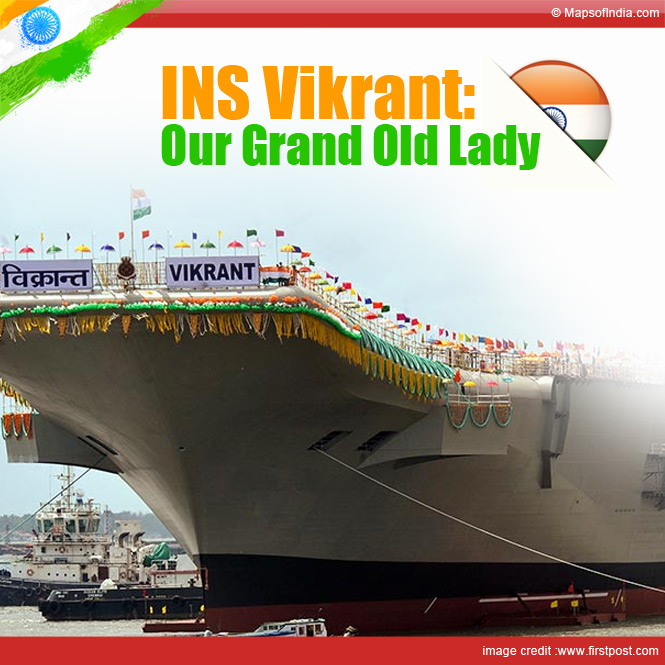In the Indian mythology, the process of death and re-birth is central to the concept of life as much as the phases of transformation within one life. This is so true for our Grand Old Lady: INS Vikrant, India’s first aircraft carrier.
Like all mothers, she arrived to hold us, nurture us, to take care of us, to protect us, to carry us through thick and thin, and so she did through her life until like with all mothers, age caught up with her. But like all our children, we don’t like to let go of our mother or father, for that matter. So it is with INS Vikrant. She sits in solitude, alone in a naval dockyard, where she awaits her fate to be decided by those she protected for so long.
Launched on 22 September 1945 as HMS Hermes in the Great Britain, she was never commissioned. After much negotiation she was sold to India in 1957, rechristened INS Vikrant (the courageous one). History has it that India did consider buying her sister, HMS Leviathan and christening her as INS Vikram, but that was not to be. India was still trying to find its feet as a young nation and budgetary constraints restricted the acquisition to INS Vikrant.
Once procured, the 19,500 ton, 213 metre long INS Vikrant was towed to Belfast for modernisation and fit-out, as per the Indian Navy requirements of the time. An angled deck was specially designed for her, steam catapults were fitted to the main deck, and several other additions were made.
The honour of being her first Commanding Officer goes to Captain Pritam Singh. In the initial phase, she was designed to host two types of combat aircraft. One was the British-made Hawker Sea Hawk, which were fighter-bombers; and the other was the French-made Alize anti-submarine aircraft. The honour of landing the first jet aircraft on her deck goes to young Lieutenant R.H. Tahiliani, who was to later become the Admiral and Chief of the Naval Staff.
INS Vikrant, being India’s most potent combat platform sailing the seas, was also the home to some of the best personnel the Navy has produced, and the training was extensively demonstrated in the combat operations of 1965 and 1971, in conflicts with Pakistan.
The INS Vikrant was dreaded by the Pakistan navy, and was Pakistan’s first priority for attack in both 1965 and 1971 operations. So much so that during the 1965 war, Pakistan resorted to psychological warfare by announcing that it had sunk INS Vikrant, when in actuality it was berthed safely for modifications!
1971 Indo-Pak War for the Liberation of Bangladesh
The origins of the conflict in East Pakistan that led to the creation of Bangladesh, lie in cultural differences between the Punjabi culture of present-day Pakistan and the Bengali culture of what we now know as Bangladesh.
In March 1971, the simmering resentment amongst the Bengali population in East Pakistan boiled over, when the West Pakistan-based ruling military regime refused to recognise the Awami League, a political party led by Sheikh Mujibur Rehman, as the winner of the first democratic elections to be held in East Pakistan. The people took to the streets, along with support from local police and the Bengali military officers and soldiers of the Pakistan Army, which were based in East Pakistan. Gen Yahya Khan, who was the President of Pakistan, ordered a military crackdown in what later came to be known as Operation Searchlight.
The brutal crackdown on the civilian population resulted in over 10 million refugees flowing into eastern parts of India, thus causing a major civil and economic crisis. India was now drawn into the conflict.
Between March and December of 1971, the flow of refugees increased and under Sheikh Mujibur Rahman’s leadership, the Mukti Bahini was born to take up armed resistance against the oppressive military regime.
The pressure was on India, since it had to face the brunt of the refugee onslaught flowing into India and the resulting tension culminated with the Pakistan Air Force launching a pre-emptive air strike on Indian air bases, on the evening of 3rd December, 1971. This was to be the decisive moment in the history of three nations: Pakistan, India and now Bangladesh.
With the war now officially declared, the Indian Navy was asked to commence a naval blockade on East Pakistan by cutting off the sea access to it. INS Vikrant, which was berthed at the Andaman & Nicobar Naval base for repairs, came under direct threat from the Pakistani Navy. Intelligence sources suggested that Pakistan was planning a strike on INS Vikrant by disguising merchant ships to get close. With two frigates, INS Brahmaputra and INS Beas, to defend her, INS Vikrant was deployed to attack and take out all naval assets berthed at Chittagong and Cox Bazar harbours.
On 4th December, 1971, from a distance of around 100 kms (or 60 nautical miles) INS Vikrant unleashed its eight Hawker Sea Hawks to bomb Chittagong and Cox Bazar. The resulting carnage was a turning point in the battle for the liberation of Bangladesh. The Indian Navy had destroyed most of the military and civil assets in the two ports. East Pakistan was now cut off from West Pakistan.
This attack shook the Pakistani military and they countered by sending their attack submarine PNS Ghazi to track and destroy INS Vikrant. The Indian Navy was looking out for PNS Ghazi and the submarine finally sank off the coast off Vishakhapatnam, its mission unfulfilled. INS Vikrant continued to sail tall and proud through the course of the battle and beyond.
For their effort in the war, the naval crew on board won two Mahavir Chakras and twelve Vir Chakras.
INS Vikrant, fondly referred to as ‘our Mother’ by her crew, continued to guard our seas, till her decommissioning on 31st January, 1997. Since then she has been patiently and quietly resting at the Naval Dockyard in Mumbai for the powers that be to take the final call on her fate. The decision was taken to send her to the scrap yard but there are way too many memories and sentiments involved that brought out people to protest the move. There are several suggestions to convert the Grand Old Lady into a Military museum, and the matter is to be decided by the Supreme Court.
The next generation of young Indians needs to know our military history and heritage, as much as it does its civilian heritage, and converting INS Vikrant into a museum could well be the way. India must ensure we preserve her, for that’s the least we can do for our Grand Old Lady.





